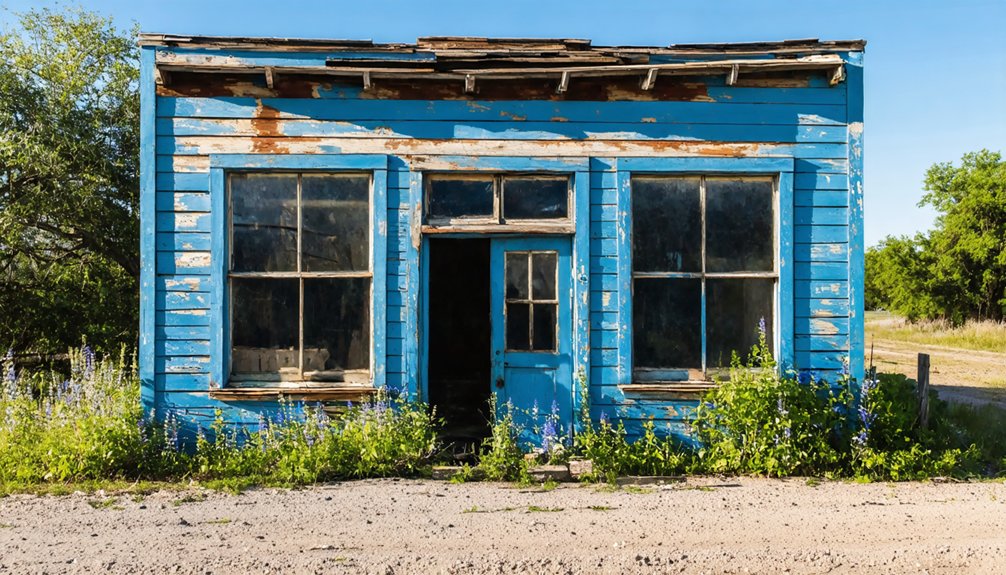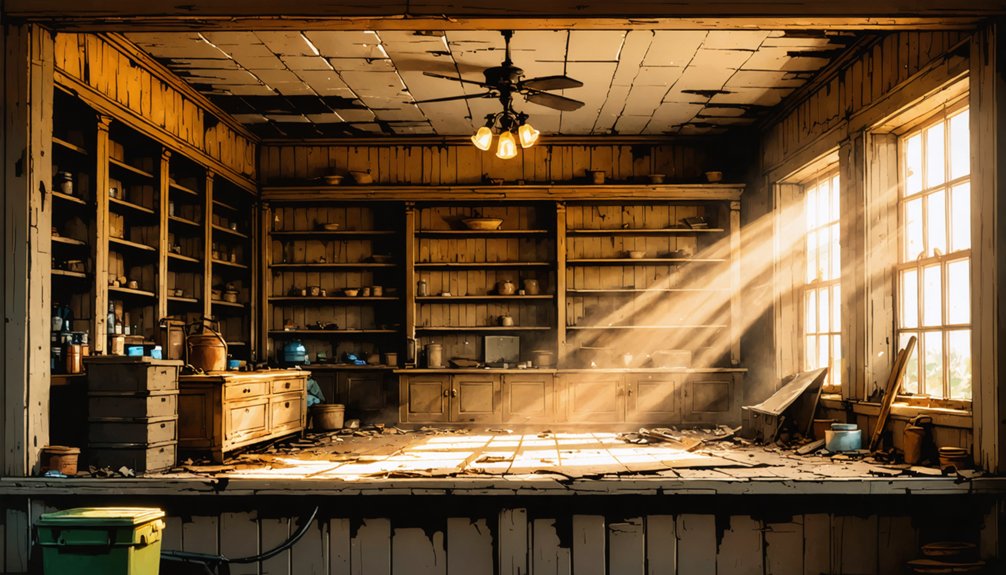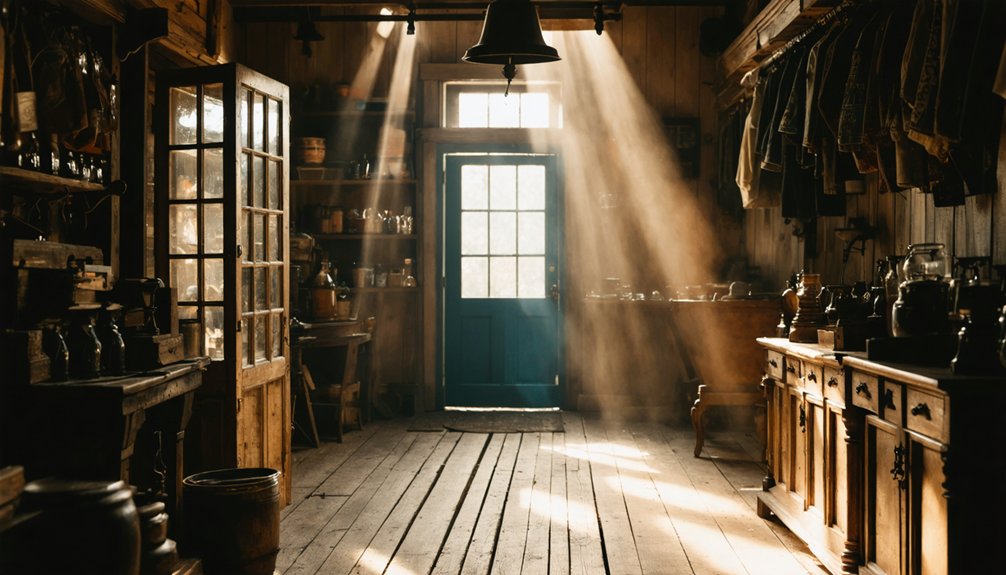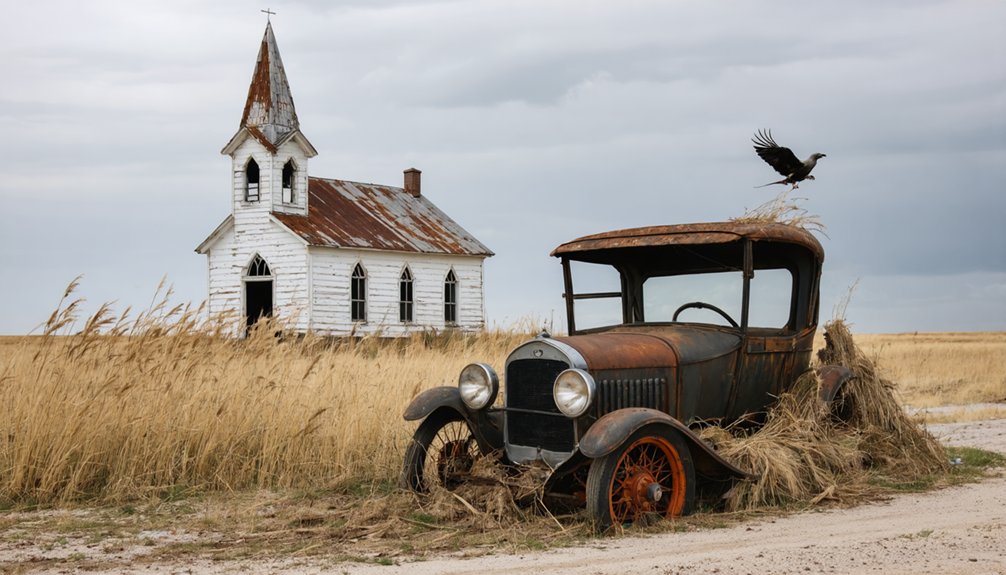You’ll discover Preston, Texas was a vibrant frontier trading post established in 1837 by Holland Coffee along the Red River. As an essential hub for commerce between Native American tribes and settlers, it thrived through strategic positioning on major trade routes and military roads. The town met its fate in the 1940s when the Army Corps of Engineers evacuated the area for Lake Texoma’s creation. Today, preserved buildings and artifacts near Pottsboro tell Preston’s compelling frontier story.
Key Takeaways
- Preston, Texas became a ghost town in the 1940s when the Army Corps of Engineers evacuated the area to create Lake Texoma.
- Originally established in 1837 as a trading post by Holland Coffee, Preston was a thriving community along major trade routes.
- Before submergence, preservationists relocated significant structures to Loy Lake Park, creating a living history village near Pottsboro.
- The town’s cemetery and Glen Eden house were among the historical structures saved and relocated to preserve Preston’s heritage.
- Preston’s decline began after being bypassed by the railroad, and its final abandonment came with Lake Texoma’s construction.
The Founding of a Frontier Trading Post
When Holland Coffee and Silas Colville established their trading post in 1829 at Fort Smith, Arkansas, they laid the foundation for what would become a crucial frontier settlement.
You’ll find their trading post didn’t stay in one place long, as they moved through Indian Territory before finally settling at Preston Bend, Texas, in 1837 near the confluence of the Washita and Red Rivers.
They’d chosen this location strategically, positioning themselves along the “Old Spanish Road” and at the crossroads of major trade routes.
The post became a critical hub of cultural exchange, where you could find Comanches, Kiowas, Wichitas, Keechis, and Tawakonis trading alongside settlers.
Coffee’s establishment served multiple purposes, from basic supply trading to the more complex task of redeeming white captives from native tribes.
Like many historical English place names, the settlement of Preston would eventually become significant in early Texas frontier history.
The location proved especially profitable due to liquor sales that attracted Choctaw and Chickasaw customers from across the Red River.
Early Settlers and Native American Relations
You’ll find that Preston’s first frontier families faced significant challenges, including the need to negotiate relationships with Native American tribes who frequently traversed the area along the Shawnee Trail.
While John Hart’s brief settlement attempt proved unsuccessful, other settlers managed to establish more permanent homesteads through a combination of trade partnerships and cautious diplomacy with local tribes.
The presence of multiple Native American groups in the region created a complex dynamic of both peaceful commerce and occasional territorial disputes, shaping the early development of the trading post community. Similar to George Lord’s settlement, early pioneers had to demonstrate resilience and adaptability to establish themselves in the challenging frontier environment. The strategic location along military and trade roads helped the settlement achieve prosperity throughout much of the 1800s.
First Frontier Families’ Struggles
The challenges faced by Preston’s first frontier families emerged starkly in the mid-1800s, as pioneers like the Preston family from Georgia and Thomas Baker established themselves in the remote Texas wilderness.
You’ll find that frontier hardships defined their daily existence. These early settlers built primitive log cabins while confronting the stark reality of isolation near the Red River bluff. Limited access to resources and a sparse population meant you’d have to be self-reliant, as community services were virtually nonexistent.
Family resilience proved essential as settlers adapted to life near Native American territories, requiring careful diplomacy and strategic settlement choices. The Prestons and their neighbors demonstrated remarkable adaptability, gradually expanding their holdings and establishing roots despite the constraints of their remote location and limited infrastructure.
Tribal Trade and Conflict
During the early settlement period of Preston, Sam Houston’s peace policies shaped complex relationships between settlers and Native American tribes through strategic treaty negotiations and regulated trade networks.
You’ll find that Holland Coffee, appointed as Indian agent, played an essential role in establishing the 1838 treaty with the Kichai, Tawakoni, Waco, and Tawehash near present-day Denison.
Trading houses became significant centers where tribes exchanged animal hides, pottery, and agricultural goods for European merchandise, though these exchanges often led to economic dependencies.
While some tribal alliances formed for mutual defense and trade advantages, others competed fiercely for resources and territory. The Caddo trade networks became especially vital, as they supplied valuable goods like salt and pottery to both settlers and other tribes.
Despite Houston’s efforts to promote peaceful coexistence through regulated commerce and land agreements, weak treaty enforcement and continued settler encroachment ultimately intensified frontier tensions.
The treaty marked a pivotal moment in the Republic of Texas era, setting precedents for future indigenous relations.
John Hart’s Brief Settlement
Among the earliest pioneers to settle Preston, John Hart established himself near a strategic bend of the Red River, where he cultivated land before 1826.
Hart’s legacy grew when he returned in 1838 with partners to clear and fence 17 acres at Washita Bend, constructing three cabins before taking sole possession of the property.
Settlement challenges quickly emerged as Hart faced the harsh realities of frontier life. After leasing his land, his tenant fell victim to Native American attacks, leading to a contentious dispute when trader Holland Coffee occupied the property without permission. He experienced similar conflicts during his earlier trapping days when Indian attacks killed two of his men.
Despite these setbacks, Hart’s influence expanded through his military service as a Texas army captain and his role as Fannin County sheriff. By 1840, he’d accumulated over 8,200 acres through land grants rewarding his service to Texas. His life came to a tragic end when he was killed by Colville in Warren, Oklahoma, during the spring of 1841.
Glen Eden: The Heart of Preston Society
Established in 1837 by Col. Holland Coffee and his wife Sophia, Glen Eden stood as a symbol of frontier hospitality in the wilderness of North Texas.
You’d find this grand plantation mansion serving as the region’s premier social hub, where notable figures like Sam Houston and Robert E. Lee once stayed.
Glen Eden’s hospitality extended beyond social gatherings, offering essential services to westward travelers. The plantation provided food, lodging, and blacksmith services, particularly when the Red River’s conditions delayed journeys. The estate offered crucial Texas Ranger protection against Comanche raids. Prior to building Glen Eden, Coffee operated multiple trading posts along the Red River in modern-day Oklahoma and Texas counties.
Col. Coffee’s legacy included not just the mansion but also a significant trading post that supplied “Forty-Niners” and settlers pushing toward the frontier.
Though Glen Eden now rests beneath Lake Texoma’s waters, its salvaged wood lives on in historical village displays, preserving the memory of this remarkable frontier establishment.
The Civil War Years and Sophia Porter’s Legacy

While the Civil War swept across the nation, Preston found itself strategically positioned along essential Confederate supply routes and military thoroughfares.
You’ll find the story of Sophia Porter particularly compelling, as she exemplified the important role of Southern women during this tumultuous period. Her contributions to maintaining community stability and supporting Confederate soldiers reflected the broader experience of women managing households under wartime pressures.
- Preston’s strategic location near military roads made it critical for troop movements and supply networks.
- Local families sent sons to fight in major battles across Tennessee and other Southern states.
- The Perry-Preston family distinguished themselves in significant battles like South Mountain and Antietam.
Through Porter’s preserved accounts and family legacy, you can glimpse how the war transformed this once-thriving Texas outpost, shaping its destiny for generations to come.
Life Along the Red River Trade Routes
At the convergence of essential frontier trails, Preston’s trading post emerged as a pivotal hub for commerce between Native American tribes and early Texas settlers.
You’ll find Holland Coffee’s trading post strategically positioned along the Red River, where it facilitated important exchanges despite the river’s treacherous navigation challenges.
The development of trade routes like the River Road and Preston Road helped you bypass the river’s dangers while connecting the settlement to Dallas and beyond.
Military installations, including Fort Johnston, provided protection along these routes, while Colonel William G. Cooke‘s military road to Austin enhanced the network’s reach.
The trading post’s significance extended beyond simple commerce – it became a cornerstone of regional development, supporting cotton plantations and serving as an essential stop along the cattle-driving Shawnee Trail.
The Town’s Final Days Before Lake Texoma

During the 1940s, Preston’s final chapter unfolded as the Army Corps of Engineers orchestrated a complete evacuation to make way for Lake Texoma.
In the twilight of Preston’s existence, government-mandated evacuations cleared the path for Lake Texoma’s inevitable waters.
The town’s economic decline had already taken hold after the railroad bypassed it to the east, severely impacting trade and limiting community resilience.
As the waters prepared to rise, preservationists worked quickly to salvage Preston’s heritage:
- The historic Glen Eden estate was carefully dismantled and relocated.
- The town cemetery was moved about a mile from its original location.
- Several significant buildings were preserved and reconstructed at Loy Lake Park.
You would’ve witnessed local groups and the Old Settler’s Association racing against time to preserve artifacts and structures, ensuring Preston’s legacy would survive even as Lake Texoma’s waters claimed the land beneath.
Preserving Preston’s Historical Buildings
You’ll find Preston’s historic buildings carefully preserved at Loy Lake Park, which now serves as a living history village showcasing the town’s heritage.
Glen Eden, one of Preston’s most significant structures dating from 1843-1845, found its second home at this location after being saved from Lake Texoma’s waters.
The town’s cemetery, including important graves like Sophia Coffee’s, was methodically transferred about a mile from its original site to maintain the community’s historical continuity.
Relocated to Loy Lake
When the Army Corps of Engineers began creating Lake Texoma in the 1940s, several of Preston’s historic buildings found a new home at Loy Lake Park through the preservation efforts of the Old Settlers Association of Grayson County.
Despite relocation challenges, these structures now serve as a living history village, preserving the historical significance of this frontier settlement.
At Loy Lake Park, you’ll discover:
- The Bass house, relocated in 1967, showcasing authentic frontier architecture
- A log cabin with a Texas Historical Medallion, featuring original peg holes and plank furnishings
- A cabin built from salvaged Glen Eden mansion logs, connecting visitors to Preston’s antebellum past
These preserved buildings allow you to experience Preston’s frontier heritage firsthand, even though the original town lies beneath Lake Texoma’s waters.
Glen Eden’s Second Home
Despite extensive historical research efforts, Glen Eden‘s role in Preston’s architectural legacy remains largely unclear, with limited documentation about its existence as a second home or its broader significance to the community.
You won’t find Glen Eden mentioned in any current preservation initiatives or historical records focused on Preston’s built heritage. The site’s historical significance, if any, hasn’t been captured in local surveys, state programs, or federal preservation efforts.
Without photographs, visitor accounts, or archival evidence, Glen Eden’s connection to Preston’s story stays mysteriously absent from historical narratives. Unlike other documented structures in Texas ghost towns, Glen Eden hasn’t been the subject of organized preservation activities, community celebrations, or educational programs.
No historical markers or interpretive materials exist to shed light on this enigmatic property.
Cemetery’s Historic Transfer
As Lake Texoma’s creation threatened to submerge Preston beneath its waters, the Army Corps of Engineers undertook a critical preservation effort in the late 1930s and early 1940s to protect the town’s cemetery.
The grave relocation project preserved both physical remains and historical legacy, including the final resting place of notable figures like Confederate spy Sophia Suttonfield.
You’ll find these key elements of historical preservation at the transferred cemetery:
- Carefully relocated graves from the flood zone to a new expanded section
- Original headstones and markers maintained through meticulous documentation
- One of Preston’s few surviving physical connections to its 19th-century origins
While most of Preston’s buildings vanished beneath Lake Texoma, the cemetery stands as a rare tangible link to the ghost town’s rich heritage.
What Lies Beneath the Waters Today
Deep beneath Lake Texoma’s waters, the historic town of Preston lies submerged alongside numerous archaeological treasures and cultural artifacts.
If you’re boating or fishing above the site today, you’ll find varying depths of water concealing pottery shards, stone tools, and trade beads from both Native American settlements and early pioneer life.
You won’t easily spot the submerged artifacts, as they rest under decades of sediment since the 1944 flooding. The site’s true archaeological wealth, part of the significant “Henrietta Focus” trading crossroads, remains largely unexplored.
About 10 burial grounds from abandoned farms still lie beneath the surface, their exact locations lost to time. The lake’s fluctuating water levels occasionally reveal glimpses of this hidden history, though most visitors remain unaware of Preston’s underwater legacy.
Visiting Preston’s Relocated Heritage Sites

While Lake Texoma’s waters now cover the original Preston settlement, you can still explore significant pieces of the town’s heritage at carefully relocated sites near modern-day Pottsboro, Texas.
Heritage preservation efforts have created an accessible network of historical landmarks that showcase Preston’s significance as a military and trading hub.
Preston’s legacy lives on through a network of preserved landmarks, telling the story of its vital role in frontier commerce and defense.
You’ll discover these key attractions:
- Restored military structures and interpretive displays highlighting Fort Preston’s role as a crucial supply depot
- Walking tours featuring relocated brick buildings and commemorative markers that tell the story of early pioneer life
- Museum exhibits housing artifacts and documents from Preston’s heyday, including items from the Glen Eden house
Local historical societies offer guided tours and educational programs, making Preston’s historical significance come alive through authentic experiences and carefully preserved remnants.
Frequently Asked Questions
What Was the Population of Preston at Its Peak?
In summary, you’ll find Preston’s population growth peaked at 500 residents in 1884, according to historical census records, before declining steadily and eventually disappearing beneath Lake Texoma’s waters in 1944.
Were There Any Documented Shipwrecks or River Accidents at Preston’s Crossing?
You won’t find documented shipwrecks or major river accidents in historical records for Preston’s crossing. While river navigation posed risks, the available records focus mainly on wagon and cattle-crossing challenges.
What Businesses and Industries Operated in Preston Besides Trading?
You’ll find plantation agriculture dominated the economy, with Glen Eden’s enslaved workforce leading production. Local craftsmanship included brick-making for military structures, while cattle operations supported the Shawnee Trail crossing.
Did Any Famous Outlaws or Bandits Pass Through Preston?
While outlaw legends swirl around Texas’s dusty trails, you won’t find documented bandit sightings in Preston’s history. The town’s trading post era ended before the heyday of Texas’s most notorious outlaws.
What Native American Artifacts Have Been Found Underwater at Preston’s Site?
You’ll find stone tools, pottery fragments, and hunting implements beneath Lake Texoma’s waters at Preston’s site, where Native artifacts were documented during archaeological surveys before the area’s 1944 flooding.
References
- https://www.redriverhistorian.com/post/the-drowned-town-of-preston-aka-coffee-s-trading-post
- https://www.ghosttowns.com/states/tx/preston.html
- https://en.wikipedia.org/wiki/Preston
- https://allacrosstexas.com/texas-ghost-town.php?city=Preston
- https://www.redriverhistorian.com/ghost-towns
- https://www.texasescapes.com/CentralTexasTownsNorth/Preston-Texas.htm
- https://www.tshaonline.org/handbook/entries/preston-tx-grayson-county
- https://www.familysearch.org/en/wiki/Preston_Trail
- https://www.okhistory.org/publications/enc/entry?entry=CO015
- https://www.texasalmanac.com/places/coffees-station



